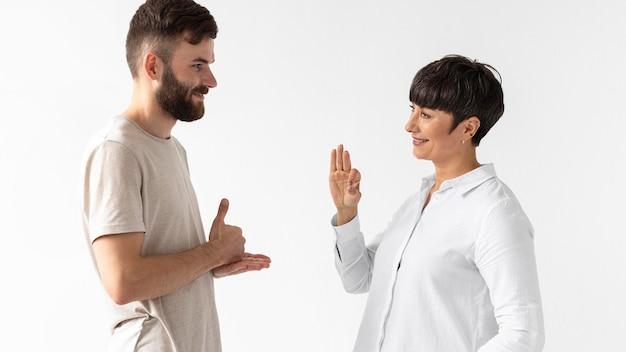Have you ever wondered how much information can be transmitted without saying a single word? Well, that’s where kinesics comes into play. Kinesics is the study of body language and gestures in communication. It focuses on the nonverbal cues that we use to convey messages, emotions, and intentions.
In this blog post, we will explore the fascinating world of kinesics and its essential elements. We will also delve into the study of Proxemics, which is closely related to kinesics. Understanding these aspects of nonverbal communication can greatly enhance your ability to interpret and convey messages effectively.
So, let’s dive in and discover the power of kinesics in communication, along with some intriguing examples that will surely make you view body language in a whole new light!

What is Kinesics in Communication?
When it comes to communication, it’s not just the words we say that matter. Our body language also plays a crucial role in conveying our thoughts and emotions to others. This is where kinesics comes into the picture. But what exactly is kinesics, you ask? Well, let me break it down for you.
The Basics of Kinesics
Kinesics refers to the study of nonverbal communication through body movements, facial expressions, and gestures. It focuses on how these actions can communicate messages and influence interactions between people. Essentially, kinesics is all about the silent language of our physical movements, just like interpretive dance without the tutus.
Examples of Kinesics in Communication
To give you a better understanding, let’s dive into a few examples of kinesics in communication:
1. Facial Expressions: The Windows to the Soul
Our faces are incredibly expressive, and they can speak volumes without uttering a single word. For instance, a beaming smile can denote happiness or friendliness, while a raised eyebrow might indicate surprise or disbelief. So, next time you want to show someone that you’re having the time of your life, try beaming from ear to ear like a Cheshire cat!
2. Hand Gestures: Talk to the Hand
Hand gestures are like the punctuation marks of our body language. They accentuate our verbal messages, adding emphasis and clarity. For instance, a thumbs-up can signal approval or agreement, while a finger wag might convey warning or reprimand. Just be careful not to accidentally give someone the middle finger when you meant to give a thumbs-up. That could lead to some awkward encounters!
3. Posture: Stand Tall and Command Attention
Believe it or not, how we carry ourselves can speak volumes about our confidence level and mood. Standing tall with relaxed shoulders and a straight back exudes self-assurance and poise. On the other hand, slouching and crossing your arms might convey defensiveness or disinterest. So, the next time you want to make a good impression, channel your inner runway model and strut your stuff with confidence!
4. Eye Contact: Look Into My Eyes
Eyes are not just the windows to the soul; they’re also powerful tools of nonverbal communication. Maintaining good eye contact shows attentiveness and interest in the conversation. However, too much eye contact can come across as creepy, so make sure not to stare into someone’s eyes for an uncomfortably long time. That might scare them away faster than a cat running from a cucumber.
Final Thoughts
So, there you have it! Kinesics in communication is the art of using body language, facial expressions, gestures, and even eye contact to convey messages without speaking a word. Understanding and harnessing the power of kinesics can significantly enhance our communication skills and help us connect on a deeper level with those around us. So, the next time you find yourself in a conversation, take a moment to pay attention to the silent language of kinesics – it might just surprise you!

FAQ: What is kinesics in communication with examples?
What is the meaning of kinesics
Kinesics is the study of body language and non-verbal behavior in communication. It refers to the gestures, postures, facial expressions, and other body movements that convey meaning and interact with verbal communication.
What is Kinesics and mention its elements
Kinesics, also known as body language, encompasses various elements that contribute to non-verbal communication. Some of the key elements of kinesics include:
- Facial expressions: The movements and expressions of the face that convey emotions and attitudes.
- Gestures: Hand and arm movements that complement or substitute for words.
- Postures: The way individuals position their bodies, conveying attitudes, confidence, or interest.
- Body movements: General body movements like nodding, shaking the head, or leaning forward, which can communicate agreement, disagreement, or interest.
What is the other name for kinesics
Kinesics is also commonly referred to as body language.
What are the rules of Proxemics
Proxemics refers to the study of how people use and perceive personal space in communication. Some basic rules of proxemics include:
- Intimate space: Reserved for close relationships, usually within 18 inches.
- Personal space: Reserved for friends and acquaintances, usually between 1.5 to 4 feet.
- Social space: Maintained with strangers and in professional settings, typically between 4 to 12 feet.
- Public space: Maintained in public situations or public speaking, starting from 12 feet or more.
What is the importance of Kinesics and Proxemics in communication
Both kinesics and proxemics play significant roles in communication:
- Kinesics helps to enhance understanding by adding different layers of meaning to verbal communication. It allows individuals to convey emotions, intentions, and attitudes without relying solely on words.
- Proxemics helps to establish social boundaries, convey consent, and respect personal space. It influences how individuals react and engage with others, enabling smooth and comfortable communication.
Is the study of eye behavior
Yes, the study of eye behavior, also known as oculesics, falls under the broader field of kinesics. Eye behavior, such as eye contact or gaze direction, communicates various messages, including interest, attention, or deception.
Which of the following will come under kinesics
Kinesics encompasses a range of non-verbal behaviors, including:
- Facial expressions
- Gestures
- Postures
- Body movements
These elements collectively contribute to non-verbal communication and fall within the scope of kinesics.
What is kinesics in communication with examples
Kinesics in communication refers to the use of body language to convey messages and meaning. For example, smiling widely during a conversation indicates happiness or friendliness, while crossed arms might suggest defensiveness or disagreement.
What is the study of Proxemics
The study of proxemics focuses on the use and interpretation of personal space in communication. It explores how individuals use spatial relationships to convey meaning, establish comfort levels, and navigate social interactions.
Is the study of body motions as a form of communication
Yes, the study of body motions as a means of communication is an essential aspect of kinesics research. Body motions, such as hand gestures or head movements, can add emphasis, clarify meaning, or enhance communication alongside verbal language.
Remember, effective communication involves understanding and interpreting both verbal and non-verbal cues, making kinesics and proxemics vital components for effective interpersonal interactions.
Now that we’ve covered the most frequently asked questions about kinesics in communication, let’s explore some interesting examples and practical applications in the next section. Stay tuned!
Disclaimer: This blog post is for informational purposes only and should not be seen as professional advice. Always consult with a qualified expert for specific guidance tailored to your needs.
